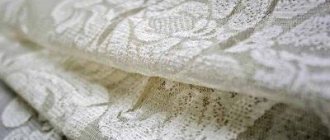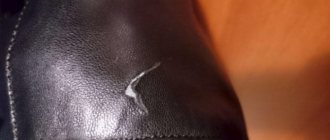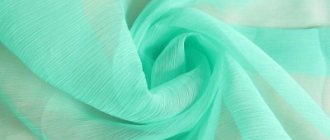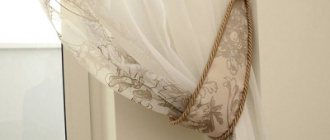Tulle is a thin, delicate fabric with a mesh structure. Tulle curtains beautifully decorate windows, are of great importance in interior design, they can reduce or increase space, and influence the amount of sunlight.
Beautiful tulle can become a central element of decor or an additional touch in the interior of the room
But their main role is decorative, so any drawback significantly reduces this parameter. If a hole from a cigarette appears in a tulle curtain, a puff has formed, or a piece of fabric has been torn out by a cat's claws, then this defect must be corrected immediately.
You can try to repair such puffs on thin fabric if it is not possible to purchase new tulle
The matter is complicated by the fact that tulle is a very delicate fabric, on which all the consequences of the repair will be visible. It is difficult to put a patch on it; it can even be impossible to sew up a vertical or horizontal cut without disturbing the structure and pattern. In some cases, if you don't know how to mend torn tulle without being noticed, it may be best to purchase a new one.
Tulle is usually sewn from delicate fabrics that require proper care and careful handling.
However, don't be upset. In most such situations, you can do it yourself, that is, make repairs: put a patch, sew up a torn cut, hide a scorch mark. And even if the repair could not be done unnoticed, beautifully laid folds can hide the place of repair.
Methods for repairing tulle
Each tulle curtain is unique.
Voile, organza, chiffon, mesh - any fabric has its own structure, uniformity, pattern. The question of how to sew tulle should be approached taking into account the characteristics of the curtain. Apply the web with glue to the wrong side of the part and simply iron the web paper on top
Then we peel off the paper from the glued cobweb
We put the decorative part that we want to glue on top, the right side of the fabric is on top, and iron it
Sometimes it is enough to simply pin or sew a decorative butterfly or feather to it to disguise the hole. Before sewing up torn areas, show your imagination and creativity. So, a hole from a burnt cigarette can be decorated with an applique from another tulle curtain. This is a labor-intensive task, but if you succeed, your curtain can take on a completely different look, more beautiful and sophisticated.
With the help of various embroideries and overlays, you can not only decorate the damaged area, but also decorate the tulle
How to sew tulle after cat claws
One of the most common questions is how to sew up tulle if it was torn by a cat. Unfortunately, pets often damage various interior items. Excessive playfulness, sudden fear - and the cat is already hanging on the curtain, clinging to it with its claws. Fortunately, there are no torn, shapeless damage to tulle. They always take the form of horizontal or vertical cuts. This is good because sewing in a straight line is quite easy.
What to do with claw holes
How to sew up a leather sofa: several ways to update furniture.
I bought a sofa, but the upholstery came apart at the seams, can I get my money back? how to sew a sofa with a hidden seam Cute pets are not well versed in brands and valuable things. They leave clues wherever their “velvet” paws can reach: curtains, down jackets, outerwear, etc. How to be in this case?
- Do not try to test the strength of a thing by stretching it in different directions, as when removing small puffs
- Carefully remove the curtain from the curtain rod and the clothes from the hanger, wrap them with the damaged part inward to avoid further injury
- Take it to a repair shop
We constantly have to deal with the consequences of sharp claws, snags from rhinestones, and tightening from “sharp” fittings. The Mobile Tailor experts are guaranteed to help
Trousers have firmly established themselves in the wardrobe of not only men, but also women. They are an excellent addition to almost any look, adding rigor and style to the outfit.
However, a small snag or snag can ruin the appearance of the product. Many owners are in a hurry to throw away or alter the product. But it is not necessary to do this; it is enough to simply rid the clothes of the puff. Let's tell you how to do this.
One of the reasons for the appearance of loops on the surface is contact with rough surfaces or sharp objects. Sometimes a fleeting touch is enough for one of the threads of the fabric to be pulled to the surface.
Snags and puffs on trousers also often appear due to improper care and improper washing conditions. Pets can also contribute to the occurrence of damage to trousers.
You can carry out the work to eliminate defects yourself at home. The work can be completed with minimal investment of personal time.
Some useful tips
How to sew a curtain with hinges
It is worth listening to the advice of experienced housewives:
- Be sure to turn the item inside out when you plan to sew it up. The front side of the item must be made perfectly, with invisible seams and knots.
- A seam ripper will be a great help when removing unnecessary stitches.
- Store needles correctly. They should be stuck into a pad or paper.
- Try to work on your own mistakes, because the first attempt may not always be successful.
- The thread should always be matched.
- Be sure to finish the work with the correct stitches, because if you leave the thread and do not fix it in any way at the end, the seam will simply fall apart.
If you are very worried and afraid to sew up the item yourself, then it is better to contact a tailor shop that will readily solve all problems with torn clothing.
https://tkanix.guru/rukodelie/kak-zastopat-dyrku-na-tkani-nezametnohttps://www.liveinternet.ru/users/trifonova_irina/post439127448/https://tden.ru/dom/kak-zashit- dyrku
Black fabric
This color is very popular - it is typical for evening and office outfits, school uniforms and many other wardrobe items. On this color, the marks left by the hot sole are especially noticeable. Let's figure out how and how to remove iron marks on black fabric - there are several proven folk methods.
Laundry soap
To remove iron stains:
- Grate part of the block and mix the resulting shavings with water;
- Soak gauze in the solution;
- Place gauze on clothing and iron the affected area without pressing.
As a bonus, read the article about what and how to clean your iron at home, we will reveal all the secrets.
Vinegar
You can also use vinegar:
- Mix a spoonful of vinegar and a glass of water;
- Place a cotton pad or a simple sponge in a glass;
- Wipe the desired area on the clothing.
Newspaper sheet
A sheet of newspaper can also help solve the problem. For this:
- Place a sheet of newspaper on the item;
- Iron on medium heat.
In another article we will explain how to remove marks from the iron if something does not go according to plan.
Pumice and eraser
A pumice stone and an eraser will help remove iron marks on black clothes:
- Take any of the remedies;
- Rub it over the affected area.
Black tea
Black tea is in every housewife's kitchen:
- Brew a strong drink – loose leaf or bagged;
- Wet a piece of gauze or cotton rag and wring it out;
- Place a piece of fabric on the clothing and iron without pressing.
Have you learned how to remove iron marks on a black dress, skirt or other item of clothing? Let's move on and figure out how to remove scorch marks from natural and synthetic clothing.
You can take a look and find out how to choose an inexpensive but good iron for your home.
Beautiful patches
How to hem a curtain from the top
Expert opinion
Smirnova Ekaterina Anatolevna
7 years of experience in interior design, professional architect
If a small hole is easy to eliminate using ordinary methods, then with a large defect you will have to use your creative abilities. The easiest way to carry out repairs is with thermal stickers. They are sold at any craft store.
Various decorative stickers are selected according to the style of clothing. By the way, this way you can not only mask damage, but also create original clothes. For children's dresses there are patches with hearts, for boys' T-shirts and pants - with images of cartoon characters.
Bursting upholstery on a sofa or chair seat is also masked with patches. You won’t be able to sew up holes on the thinnest tulle unnoticed, but thermal stickers with floral patterns, butterflies, etc. will come to the rescue.
Do not rush to get rid of the product if its defect can be repaired. A neat stitch or a beautiful appliqué will bring the item back into service.
Elbow patches - how to sew them on to make them look neat?
To restore the sleeve in the elbow area, you can use any of the listed types of patches. If you want to not only repair an item, but also give it a unique appearance, then you should try the option of using a kind of woolen heel. This move will look best on a thick or light sweater or sweatshirt.
We recommend: How to fold a shirt correctly after ironing or carefully place the product in a suitcase?
The manipulation looks like this:
- We prepare everything you need. In addition to the sweater, we will need a thick rectangular sponge, a mold (profile or confectionery), colored wool, felting needles and tape.
- We put on a sweater, bend our elbows and glue pieces of tape at a distance of 2-3 cm from the fold. Thanks to the marks, everything will be done smoothly.
- After this, we pull the sleeve over the sponge, apply the form, focusing the bottom edge on the tape, and line the form with wool.
- Then we felt the wool using the traditional method, piercing it with a needle located at a right angle. We act until the fluffy wool turns into a dense layer.
- We remove the form and fix the work by steaming with an iron. This way you can decorate one sleeve, but the product will look more harmonious with two similar patches.
If everything was done correctly initially, the patches will not require special care. They will last for a long time, maintaining their original neat appearance.
Rules for sewing curtain tape on tulle
The need to shorten the finished product arises if the measurements were taken with errors or, for example, the cat tore the bottom edge.
When the edges on the sides or bottom have already been factory-finished, damage to them can degrade the appearance of the material. For this reason, cutting the fabric is often done from above - where the curtain tape is sewn.
When the product is shortened, the strip is sewn on again.
The rules to follow when hemming are as follows:
- Natural materials are washed first (they shrink). If you attach a tape to the curtain in advance, then after drying the product may become deformed.
- Long curtains can stretch under their own weight, so they must be hung on the curtain rod before performing any manipulations. This should be done if you plan to sew curtains to the floor.
- It is easier to take measurements in a vertical position with curtains. Pins are used to secure the material.
- When high accuracy of measurements is not important, when determining the length of the curtains, the distance between the cornice and the desired length is taken as a basis.
- Synthetic materials can be cut provided that a bend has been made along the edge first. The fabric is fixed in this position with an iron: the resulting line serves as a guide when cutting.
- There is no need to cut natural materials: they are torn one by one. The result is a sloppy edge, which is then processed.
Fabric processing depending on its type
Different materials require different treatment. To achieve the desired result, you must follow some rules for caring for them.
How to process cotton and linen
To iron curtains made of cotton and linen, they need to be starched when washing. Curtains are ironed wet using the appropriate temperature conditions. An iron with a steamer is best. It will help give the desired look to such materials.
When working with curtains made of cotton fabrics, their density is taken into account. Batiste is also made from cotton. This is a thin and delicate fabric that requires careful and careful handling. It is better to iron cambric curtains dry, observing a gentle temperature regime (for example, for silk). These curtains are ironed vertically. It is necessary to check the cleanliness of the sole of the device so as not to deform the fabric. Tissue paper works well as a liner when ironing these curtains.
How to handle polyester and viscose
These delicate fabrics require gentle handling. Viscose and polyester should be ironed with an iron heated to +140°C without wetting. You need to iron them from the wrong side on the ironing board, starting from the upper left corner, moving away from you until you reach the bottom edge
Smooth the fabric carefully, without pressing on it
Washed curtains should be immediately hung on the curtain rod if there are no folds on them. They will dry quickly and look neat without ironing.
How to work with velvet
Velvet is quite difficult to care for and must be handled with care. After washing, the curtains must be wrapped in a fabric that absorbs moisture well, wrung out to prevent wrinkles from forming, and dried
When ironing velvet curtains, it is better to do without steaming. Place a thick soft cloth under them and then iron without pressure along the direction of the pile.
How to handle thin chiffon and organza
Organza and chiffon curtains can be ironed using a steamer. They require quite delicate care. To avoid damaging the fabric during steaming, it is better to iron it several times. The device must be kept at a distance from the curtain.
You can iron organza with an iron with a steam function, which should also be kept at some distance from the fabric.
Washed curtains made from these fabrics can simply be dried on a curtain rod, and all unevenness can be smoothed out with your hands.
Silk fabric
This is a soft and delicate fabric. We iron silk curtains only from the wrong side, setting the temperature intended for such fabric. Silk should not be ironed while wet and should not be steamed to avoid damaging it. If the material is dry, you need to put a damp soft cloth on it for several hours.
How to iron a curtain that has embroidery on it
Before you start ironing such a curtain, you need to spray it with water from a spray bottle. The product should be ironed only from the wrong side, without pressing on the areas with embroidery using the device. This way you will save the relief of embroidery and decorative elements.
The lambrequins should be ironed damp, using the delicate setting, carefully passing the iron through each fold.
What to do with lined curtains
In order to give such curtains a neat appearance, they must be ironed on both sides. These curtains are made from different types of fabric, so use a different temperature setting for each side.
How to wash tulle in a washing machine: loading features, temperature and washing modes
Before putting the tulle into the drum, you need to carefully fold it - if you load the fabric in a crumpled form, after washing there will be creases on it. If we are talking about muslin, veil, thin organza with embroidery and other particularly delicate fabrics, it is better to place neatly folded curtains in a special mesh bag for washing - this will not interfere with washing, but will save the fabric.
The tulle is washed in the delicate wash mode - at a temperature of 30° and without spinning. During this type of washing, the drum of the machine rotates more smoothly, and washing occurs with a large amount of water - this minimizes the risk of damage to thin fabric. You can wash tulle curtains on the silk and wool cycles - they are as gentle as possible.
When loading detergent into the machine, be economical. In most cases, housewives add powder or shampoo for washing generously, from the heart. In the case of washing tulle, this can lead to increased foaming, especially if mesh fabric is sent in the wash. Therefore, check the dosage recommended by the manufacturer and, since the fabric is light and the machine operates with an incomplete load, reduce the dose by half.
When washing curtains, it is advisable to use the extra rinse function: residual detergents also lead to premature yellowing of the fabric.
After finishing the washing cycle, you need to remove the tulle from the machine, let the water drain and, without squeezing it, hang it on the curtain rod. If the curtain is voluminous, you can lightly squeeze it out manually, with very light movements, without twisting.
Once dry, the fabric will straighten under its own weight. You can iron tulle only in the most extreme cases, and very carefully - this also leads to yellowing of the fabric.
Repair of various types of tulle
Repairing damaged tulle is a technologically complex process. Curtain fabric can be restored more easily, it does not creep, it allows you to use darning or embroidery to cover the defect as much as possible, install patches or replace elements.
If a hole from a cigarette appears in a tulle curtain, a puff has formed, or a piece of fabric has been torn out by a cat's claws, then this defect must be corrected immediately.
It is much more difficult to repair tulle, regardless of whether the fabric is woven or one-piece, with or without a pattern; during processing, asymmetrical arrows, puffs, and puncture holes often appear. As a result, a larger area has to be processed and the appearance of the fabric changes significantly. At home, it is easier to fix torn tulle if the hole is small, tightened, or burnt.
You can try to repair such holes in thin fabric if it is not possible to purchase new tulle.
All types of tulle can be divided into several types, each of which has its own characteristics and requires its own approach when repairing.
- A veil is a soft fabric made of silk, wool, cotton threads or polyester that does not require special care, often with a printed pattern and other decorative elements.
- Organza is a wrinkle-resistant, durable material made from polyester (expensive fabrics woven from viscose and silk are also available).
- Mesh is a type of tulle with a perforated structure.
The matter is complicated by the fact that tulle is a very delicate fabric, on which all the consequences of the repair will be visible.
In order to answer the question of how to quietly repair tulle, it is necessary to take into account the desired result and what needs to be achieved. In addition to simply eliminating punctures, puffs or sewing up defective holes, you can use shortening curtains, sewing on additional elements, darning, decorating with embroidery or other methods.
On the Internet, experienced housewives often share tips on how to sew tulle correctly.
You can change the size of the curtain and add narrow or wide lace.
Tulle damaged by a cat
Pet owners periodically face the question: the cat tore the tulle, how can I repair it? Cats do pick out curtains made from this material, and damage can appear throughout the entire fabric. Usually these are pinpoint injuries from claws. Darning such holes will completely ruin the appearance of the product.
It’s better to use your creativity and turn an ordinary tulle curtain into a designer fabric.
Handicraft stores offer a lot of iron-on appliques of various colors and shapes. It is necessary to select elements that combine with each other and do not fall out of the overall color scheme of the room. The adhesive strip is attached to the base and then ironed at medium temperature to the damaged area. In this case, the tulle will not deteriorate from high temperature, and the applique will be securely attached to the canvas.
Properly selected glue applications will help you quickly decorate tulle without much effort.
Embroidery on tulle will look original and appropriate in any room.
This option is also suitable for cases where burnt holes from cigarettes appear on the fabric - this happens quite often in apartments with smoking owners. Thin stickers will also save chiffon - it is impossible to sew up a hole in this fabric unnoticed.
If there is a small hole in the tulle, you can take a decorative ornament and sew or pin it on a pin.
If you need to sew up tulle that has been torn vertically by a cat (this happens if the animal hangs on a thin fabric), the easiest way is to use spider web thermal tape, sold in handicraft stores. The threads at the break site are carefully combined, an additional thread is placed on the inside to provide strength, and a thermal tape is applied on top. The tear area will be noticeable if it is against the background of light from a window, but this is better than a holey curtain.
If everything is done technically correctly, there is no guarantee that the repair site will not be visible.
Sometimes, it is a creative and non-standard approach that gives a positive result.
The next option is to use a donor fragment. The tulle can be taken from the edge of the curtain, if the width allows it, or purchased separately. The frayed edges of the tear are cut out, a new piece is placed in its place, the direction of the threads is tracked, and from the inside, the resulting structure is also connected with the same tape using a cobweb.
The place of such connection is quite strong and can withstand washing.
How to sew up socks so that they are not visible?
It is not recommended to sew up woolen socks using the usual method or with thin threads.
How to sew socks so that they are not visible:
- To do this, you should use special equipment, but you must have experience working with knitting needles or crochet. First you need to cut off the torn edges with scissors and release the loops.
- Using knitting needles or a crochet hook, new ones must be threaded through these loops, using woolen thread that matches the color of the socks. It is desirable that the quality of the thread, as well as its thickness, be approximately equal to the structure of the fibers of the sock. After casting on the loops on the knitting needles, it is necessary to knit the sections using regular stocking or garter stitch.
- It depends on the technique used to knit the wool sock. With the use of this technique, it will be possible to completely avoid seams. The cast-on loops are shortened by double knitting or pulling the thread through. The easiest way to close all the loops is to tighten them with one thread. Thus, a semicircle is obtained. This type of sock repair is ideal if the hole is located on the heel.
Piecing method
Tip #2: how to apply a patch correctly
It is necessary to provide first aid to frayed clothes in a qualified manner. This means that the new mother not only needs to know how to mend a hole in her pants, but also master the art of hand patching.
When a child, returning from a walk, brings a piece of fabric in his palms, and a piece of cloth has been torn out on his knees, then he will have to put on a beautiful patch. To do this, the torn edge is brought into accordance with a shape reminiscent of a geometric figure. To make the insert relatively invisible, it is recommended to select fabric to match the main color of the clothing.
The prepared flap must first be washed. If the fabric shrinks, make larger allowances.
Let's begin the correct process of sewing on the patch:
- We turn the product inside out and apply the blank with the front side. Check that the pattern on the fabric matches or the grain threads are located in the same direction.
- We fasten the parts with running stitches.
- We bend the edges of the patch and secure them using a blind stitch.
- Mask the edges of the hole. We bend them inward and sew them up in the same way.
- Remove the contrasting basting thread.
- Iron the insert fragment.
It is not always possible to sew up a hole neatly and correctly. There is also a way out of this situation. Buy a iron-on adhesive in the sewing department and use an iron to attach it to the place where the fabric was torn. When it comes to trousers, create symmetry on them using the same or different appliqué elements.
Curtain repair | .
Here are some notes for those who want to repair curtains themselves, lengthen short ones, shorten long ones, and eliminate some defects in curtains.
Not always and not everyone has the opportunity to purchase new curtains, for example, if you move, or maybe you simply ruined the curtains in some place. Well, don't throw them away!? You and I will need some minor repairs to the curtains, and we can easily handle this.
Repair of curtains in the form of an extension
This is exactly the moment that happens in most cases of curtain repair. You want to move the curtains to another room; you moved to another apartment with higher ceilings; you just got the wrong size. What to do? How to lengthen curtains?
There's nothing wrong with that. There are several options for repairing curtains that allow you to turn short curtains into a product with a normal length. If you don’t know how to measure the required length of curtains, then take a look here.
Lengthening curtains with fringe
The correct choice of fringe height will allow you to painlessly and easily lengthen the product to the desired height. Thread fringe is best suited for our purpose. You can also use fringe with tassels. Read more about choosing fringe here.
Remember that you need to take 10-15% more fringe, since it shrinks a lot during pre-steaming.
Extending curtains using the curtain itself
If you need a slight extension, 5-10 cm, then perhaps you can get by with a simple action. Take a look at the bottom of your curtains. If we are talking about night curtains, then, in most cases, curtain salons and curtain manufacturers leave a good hem along the bottom of the curtains, on average 5+5 cm. Gently prop up the bottom of the curtains and iron with the steam function to smooth out creases. If there is no fabric left for hemming, then you can use the option of lining with another fabric, where the joint of the fabrics will be the lower edge of your curtains.
Here is a video on how to add a piece using another fabric:
Lengthen using the same fabric
For extensions that require more than 10 cm, the best solution is to add curtains at the top or bottom with the same fabric as the curtains themselves.
Where did you purchase the curtains? It’s good if in the nearest salon. Do you perhaps have leftovers from the height when sewing? If not, go to the same salon and purchase the missing piece in order to add your curtains.
For options for curtains in a deep niche, add the curtains from above.
For the rest, we add curtains from the bottom or top and hide the joining seam using decorative braid or, again, fringe.
The quality of work without finishing with decorative braid should be ideal.
Lengthen curtains using contrasting fabric
Repairing curtains involves not only lengthening them, but also giving the curtains a decorative look that will not allow the viewer to doubt the quality of the workmanship and the decorator’s intentions. That is, no one should guess that the curtains have been altered; on the contrary, it is a drawback, and in this case, combining with another fabric should become a highlight, a flirty and fashionable detail of your curtains.
In order for combining curtains with contrasting fabric to look harmonious, you need to use a color that contrasts with your curtains, in complete harmony with your interior. For example, you have not only curtains, but also a lambrequin consisting of two colors. Use them. And don’t forget that the joint must be covered with decorative braid or other decorative elements.
You can read more about combined curtains here.
If you don't have a cornice yet and your curtains are too short, consider a round cornice and curtains with grommets. Your curtains can be used as main curtains, and the bar with eyelets can be used as a contrasting curtain.
This article will help you calculate the number of eyelets for curtains.
Shortening curtains
One of the easiest ways to repair curtains is to shorten them. The main thing is to correctly remove the required height of the product. Next, similar to your curtains, we shorten the product.
How to hem curtains from the bottom at home: step-by-step instructions describing the process
There are two ways to shorten curtains - trimming and folding. In the first case, you should measure the fabric correctly and cut the fabric to the required length. Before starting work you must:
- Wet the curtains and hang them on the curtain rod without squeezing them. Leave the textiles for 3 days. This will allow the fabric to sag and allow more accurate measurements to be taken.
- Select threads for curtains. They must match the shade of the material.
- Prepare suitable pins. Do not use thick tools as they leave holes in the fabric.
The shortening method and type of seam are chosen depending on the type of material:
- Tulle, organza, and other thin fabric can be set on fire. This will seal the threads and prevent them from unraveling. The main thing is to perform the procedure carefully so as not to set fire to the canvas.
- Dense material may bend after hemming. This problem often occurs with blackout fabric. To prevent the night curtain from losing its shape, a weighting agent is inserted into the bend. Usually a wooden plank is used. If the products were originally sold with a load, the length should be cut not from the bottom, but from the top. To prevent the curtain from losing its shape, curtain tape is sewn on.
- If the material crumbles, the edge is additionally treated with a zigzag seam. This will fix the threads and increase the service life of the fabric.
- Double-sided curtains cannot be hemmed in the usual way, as this disrupts the design of the canvas. Such curtains do not have a front or back side. In this situation, the textiles are cut, the edges are folded inward, and sewn with a hidden seam.
To shorten curtains, the following types of processing are distinguished:
- Classic seam. This is a straight stitch that is suitable for both light curtains and heavy curtains. The fabric is simply folded and stitched. If the material crumbles, make 2-5 bends.
- Blind seam. These are hidden stitches that are used to seamlessly join two warps together. They do not pierce the fabric with a needle, but make a small grab of the thread. This results in a neat hem.
- Using edging. When the curtain fabric is thick, it is not folded. If you fold the material and sew a seam, the edge will be too thick. He looks unattractive. In such a situation, excess fabric is removed, that is, the bottom is cut to the desired length. No allowance is left. The braid is sewn on with a hidden seam.
- Gusset. This is the most difficult way to shorten curtains, but after the procedure the products look aesthetically pleasing. The angle turns out to be neat, not too tight, and not puffy. This method can only be used by experienced dressmakers.
Processing the bottom of the curtain with a corner
Before starting the hemming process, you need to take measurements of the fabric. To carry out the procedure correctly, adhere to the following algorithm:
- Textiles are laid out on a flat surface. It's better to work on the floor.
- If the material is very wrinkled, it will be ironed.
- Use a centimeter or tape measure to measure the desired size.
Fabric trimming is performed only if the fabric is too long. If the size of the canvas is 10 cm larger than the required value, the textiles are simply folded and hemmed. This will allow the curtains to be returned to their original dimensions if necessary.
When the measurement has been made and the modeling method has been selected, they proceed directly to the procedure. This can be done in several ways.
Manually
This is the longest method of hemming curtains. It is usually used if you need to reduce the length of the curtains without removing them from the curtain rod.
Procedure:
- The curtains are measured. On the wrong side, use chalk to mark to what length the curtains need to be folded. If necessary, trim off the excess.
- They make a bend. The fabric is folded flat and ironed. Fasten with pins. For thick curtains, the material is folded only once. Tulle can be folded in 2-3 layers.
- Perform hemming. The main condition of this method is to leave a thread 2 cm long at the ends, and not thread it to the end, so as not to form a crease.
On a sewing machine
This is the fastest way to hem curtains. Algorithm:
- The fabric is folded and trimmed. Fasten with pins.
- Perform estimates.
- Textiles are sewn on a sewing machine.
- Remove the mark.
- The threads are tied into a knot at the ends.
Using adhesive tape
To bend curtains using this strip, proceed as follows:
- Measure the width of the canvas. This value must correspond to the length of the adhesive strip. If the indicators do not match, the procedure will not work.
- The curtain is folded. To fix the material, heat treatment of the canvas is performed.
- Adhesive tape is inserted into the crack. The top of the fabric is treated with a hot iron.
This method of shortening the length of curtains can only be used for light fabrics. The sticky strip will not support the weight of the dense material.
Hole on lace and guipure
Restoring torn guipure or lace is a painstaking task that requires special patience, and in most cases also experience in lace weaving. Repairing a lace product will make it easier to pre-align the edges of the hole to avoid mesh breaks.
If the hole is not noticeable, you should try to find a matching guipure pattern in stores and hem it with a thin single thread from the bottom.
You can try to restore the lace mesh pattern so that the seam from the patch is not visible. A rougher finish will be obtained by crocheting the mesh.
To do this, a strong thread will need to be tied into small bundles. The most accurate restoration of the pattern is achieved when weaving lace using bobbins - special spools onto which yarn is thrown.
There is a puff
We also turn a disadvantage into a highlight. Along the tightening line, we sew decorative braid or fringe into the overlay.
We crown it all with a bow, tassel and other decor. You can take the ribbon in a contrasting color. If one line of braid does not look
finished, then you can sew another one. Your imagination will help you.
If you lack experience in sewing, it is better to trust the professionals, because... poor stitch quality in this case will be
strike the eye.
Basic recommendations
Even novice housewives can sew up a hole in clothing correctly. First, familiarize yourself with the standard repair rules:
- To prevent the seam from being visible on the fabric, the thickness of the needle must correspond to the density of the material. A needle that is too thick leaves unsightly holes. Ideally, it is better to take a bead embroidery needle - the thinnest one.
- Do not forget that the color of the threads should match the fabric as much as possible.
- Make sure there is enough thread in the needle.
- Work slowly.
- Always have a steamer with you.
- The needles must be new, smooth and free of rust.
If you can’t make a beautiful and invisible seam the first time, don’t worry and practice again. Sewing is a difficult task, but with practice it becomes enjoyable.
How to sew a hole in a sweater
For large knit items, such as sweaters, wool socks and similar clothing, it is better to use repair methods such as:
- Darn. This method is classic for repairing knitwear. The degree of imperceptibility of the result depends on the size of the hole, the material itself (it will be very difficult to mend silk or other delicate fabric unnoticed), and the skill of the seamstress. Darning is often used to repair clothing in inconspicuous places. At the same time, the method copes with the task perfectly - it will help to sew up a hole made in a knitted sweater.
- Embroidery. The method allows you to turn the place where the hole was into a decorative element - embroidery. The method involves two stages: creating a base for embroidery and directly decorating. First, you can mend the hole with regular threads in color, and apply embroidery on top of them. You can also glue adhesive-based material from the inside and decorate it. Another option is to patch the item. A patch is glued onto the “web”, after which you can embroider on top. Virtuosos can darn and form a pattern at the same time. This method helps turn a flawed item into an original piece of clothing. The downside is that this method requires more time, selecting a drawing and completing it.
Darn
To darn a hole in knitwear, you will need threads that match the color of the fabric of the item, a hand needle, a “fungus” or other darning device:
- Before starting work, run a needle and thread around the hole so as not to pull the material. During the work, you can not touch this thread, and then simply pull it out.
- To sew up the hole, use a darning tool and begin to form a mesh of thread of a suitable color, repeating the pattern and indentations as in knitting a product.
- When finished, fasten the thread securely and pull out the stitching.
Embroidery
You can securely and beautifully sew up the hole using embroidery. Prepare in advance a “mushroom” for darning, a hand needle, threads for darning and embroidery, and an embroidery pattern, if necessary:
- First you need to sew up the hole using the darning method, use a thread to match the product, a needle and a “fungus” for this, follow the steps from the instructions described above.
- On top, embroider according to the prepared pattern; try to select a pattern that completely covers the darning area. Often, embroidery is “brought” onto entire sections of a knitted product.
How to hem curtains: master class
Even if you buy ready-made curtains or sew them to order, hemming curtains at home with your own hands has its advantages. When you're hemming your own curtains, you can get the exact length you want by hanging the curtains on a curtain rod and exploring different options. Perhaps what satisfied you at the idea/sketch stage, you will want to adjust on the finished curtains, making them a little longer or shorter. Therefore, when ordering, making with your own hands or buying curtains, it is optimal to choose a length slightly larger than needed according to measurements, and then hem the curtains yourself.
You will need:
- curtains;
- centimeter and ruler (ideally a tape measure);
- chalk;
- sewing machine and threads to match the color of the curtains;
- overlock (if available);
- iron;
- pins.
Sequence of work:
1. Decide on the desired length of curtains
To make the choice clearer, you can hang ready-made, but not hemmed, curtains on the curtain rod and try different options, for example, pinning the bottom with pins.
There are four classic, basic curtain length options:
- curtains up to the window sill;
- curtains just below the window sill;
- curtains to the floor (or a couple of centimeters above the floor);
- an extended version, when the bottom of the curtains lies on the floor.
The first two options are good for curtains on a kitchen window.
The third option is the most common, suitable for most living rooms.
The fourth is good for an interior in a romantic style, for thin translucent curtains or, conversely, for thick curtains designed to reliably protect the room from light and drafts.
2. Make markings
It is better to leave new curtains hanging a little on the window so that they straighten out and take shape. Accurately measure the desired length, remove the curtains and draw a straight line at the bottom of the finished product with chalk. A wide hem is suitable for curtains - you don’t have to cut off excess fabric up to 20-30 cm, it’s better to cut off the rest (focus on the height of the ceilings, the length of the curtains and their model). It is better to fold single-layer curtains made of not too thick dense fabrics twice during processing - it is the double fold that will “hide” the excess length of the fabric. It is better to fold curtains made of heavy thick fabric or double-layer curtains once, first cutting off the bottom edge evenly and processing it using an overlocker or a zigzag sewing machine.
This video explains in detail and clearly how to determine the required length of curtains if you choose floor-length curtains (and this is the most difficult, although the most common option):
3. Hem the curtains
3.1. Fold the bottom edge of the curtain to the wrong side and press. (For thick or double-layer curtains, do not fold the bottom, but finish the edge of the fabric.)
3.2. Fold the edge of the curtain over again and iron or pin
Please note: the hem line (on the left, see photo) must correspond to the bottom line of the finished product
3.3. Sew as shown in the photo. Make bartacks at the beginning and end of the stitching.
3.4. The edges of the hem can be left loose, stitched by machine, or carefully sewn by hand with a blind stitch.
If, after the unhemmed curtain hangs on the curtain rod, the fabric in the middle of the curtain “sags” a little and stretches out (this often happens with heavy curtains), minor adjustments need to be made in the process of hemming such a curtain.
To make the stitch line even, you first need to iron the hem along the bottom line, and then lay out the second hem evenly (using a ruler) so that its width is the same across the entire width of the curtain.
More details and clarity in the video:
How to repair tulle
If you have any questions, you can consult for free via chat with a lawyer at the bottom of the screen or call by phone (consultation is free), we work around the clock.
The decision of how exactly to repair the tulle depends on the volume of the torn area and its location. It is impossible to sew up an oblique cut without visible results, and the fabric will fray. If the cut is located closer to the middle of the curtain, it is easier to cut out the damaged area and extend the cut. There is a lot of room for imagination when repairing curtains or curtains. The curtain can be divided into two parts or folded into blocks, resulting in a different design solution. The edges of the fabric, in order to avoid fraying, are treated with a candle, and then processed with an “American” stitch, and the edges of the thread are passed inside the folded areas. If it is torn in the middle, we make a split tulle from two halves, cutting out a piece with a defect. You can in the same way connect together two pieces obtained after removing a hole or a long horizontal tear in the fabric and sew them into a single fabric. It will not be possible to make the seam invisible, but this situation can be played up for design purposes and a contrasting narrow strip, the color of which matches other interior items, can be sewn to the junction of the two parts. We cut out the torn piece horizontally, sew it back, and decorate it. If the damage to a large area is located below, it is possible to consider an option in which the curtain can be shortened. If this is not possible or does not fit with the overall design of the room, it is easier than buying new tulle to purchase fabric that matches the style and add the missing length by stitching the old and new pieces horizontally. If the tulle is torn at the top or bottom, sew another one, or a contrasting piece of tulle.
What is curtain tape and why is it needed?
Curtain tape is a soft type of fitting that is sewn to the edge of curtains and curtains. It usually has loops that are used to hang the curtain from the curtain rod.
One or more cords pass through the braid, sometimes they are supplemented with pockets. This design allows you to create various folds on the curtain. The type of drapery depends on the number of cords, the presence and shape of pockets.
Thanks to curtain tape, when making curtains you do not have to manually sew on loops and form uniform folds directly on the material. All these functions are performed by fittings that can be easily sewn on with a few lines.
Curtain textile accessories come in different varieties. It is classified by:
- Size. There are options from 1.5 to 10 cm wide. The heavier the curtain, the wider the tape should be. Typically, for light translucent fabrics, ribbons 2.5 cm wide are used, and for dense, heavy materials, six-centimeter fittings are used.
- Method of fastening to the curtain. There are sewing tapes, which have to be sewn onto the curtains, and adhesive tapes, which are glued to the fabric. The second option is considered less reliable and is only suitable for light curtains.
- Fastening elements. Usually, to attach to the cornice, there is a ribbon on the braid that creates loops. However, there are options with other fasteners: Velcro, eyelets, clothespins, etc.
- Blossom. Curtain braid can be white, translucent, transparent or colored. Transparent options are suitable for translucent, thin and light curtains, and thick white and colored ones are suitable for heavy, light-blocking curtains. Colored varieties are chosen in accordance with the color of the curtains.
- Material. For organza and veil tulle, fishing line accessories are used; for denser fabrics, a ribbon made of cotton, polyester or cellulose is suitable.
Another parameter for classifying ribbons is the type of folds that will be created when the cords are tightened. The calculation coefficient also depends on this:
"Harmonic". Forms simple thin symmetrical folds. The build factor in this case is 1.5, and the width is 6.
"Pencil". A classic variety that forms a simple, uniform assembly along the entire length of the canvas. Coefficient – 2.5, width – 7–7.5.
"Wave" (sometimes called "sleeves"). Forms several massive rounded folds throughout the canvas. Suitable for heavy fabrics. The width of the braid can reach 10 cm, and the coefficient is 2.
French assembly. When using braid, groups of folds are formed on the curtain, each of which includes 3 thin gathers. This variety looks best on long curtains. The coefficient is 2, and the width is 8.5.
Double pleated. Forms groups of three thin folds in a checkerboard pattern. Wide braid (10 cm) has a factor of 2.
“Waffle” (other names: “butterfly”, “chess”). Forms a diamond-shaped drapery. Coefficient – 2.5, width – 7.
Counter folds. They move from different directions towards each other. The width of the braid from the counter assembly reaches 2.5 cm, and the coefficient is 2.
"Glasses" (Flemish folds). Groups formed from several assemblies that smoothly transform into one rounded fold. This drapery resembles a glass with an elegant thin stem. Used for heavy curtains in luxurious interiors. Assembly factor – 2.5.
How to sew up longitudinal damage to an item
The main rule when restoring a damaged item is to act without haste and carefully. Despite the small size of the longitudinal tear, you will have to spend a lot of time if you want to make the seam almost invisible, but the result is worth the effort.
READ ALSO: Sex shop: reasons for popularity
Algorithm:
fold the edges of the problem area into the middle, carefully sweep it using a “forward needle” seam from the inside out; the next stage is strengthening the darning line using an over-the-edge seam; If the technique is followed, hand stitching turns out smooth, almost invisible; If the seam is long and the clothing repair area is clearly visible, you can decorate the product using the method described in the next section.
Tulle on top of curtains | .
Tulle on top of curtains is one of the common ways to keep the window clear and at the same time achieve light-proofing.
What are the main features of such decoration? About everything in this article.
Tulle on top of curtains
How often do I hear from buyers that they are tired of a busy space and want to take a break from lambrequins and heavy curtains. I agree with this. Some style solutions only require the presence of light tulle in the interior. But what if you need to get some sleep during the day or hide from curious passers-by for owners of housing on the first floors, and on other floors there are curious eyes opposite? And here some come to mind
tulle decoration options:
- Tulle on top of curtains
- Blinds and tulle
- Roller blinds for window sashes and tulle
- Roman blind and tulle
Why do we choose tulle on top of curtains today?
This is still a rather uncommon type of decorating curtains, arousing keen interest among those who strive for something new, not hackneyed and interesting. Praise from guests and the demand to tell you how you did it are guaranteed.
Tulle on top of curtains
In relation to other solutions, tulle on top of curtains leaves the possibility of decorating with a good filling of the fabric, which gives softness to the interior, while other methods tend to minimalism and office-ness.
This option, tulle on top of the curtains, will appeal to those who often change the decor in the house, move furniture, rearrange sofas and flower pots. Swap tulle with curtains, and a new design with new sensations will bring you new emotions.
What types of tulle decoration on top of curtains can be called?
Background curtain
Option to use curtains as a background. In this method, it is good to use tulle on top of curtains, a bright plain curtain, and tulle with a plain light pattern. On a rich basis, the pattern will be pronounced if the tulle is gathered on top of the curtains with tiebacks, and if not, then the curtain will be a little more subdued, but also expressive.
Tulle on top of curtains
Invisible tulle on top of curtains
If you take a curtain to match the organza tulle (you can play with halftones), and use very thin, transparent organza, then the mysterious effect will amaze you with its harmony and completeness.
Tulle on top of curtains
Multi-layering
The use of several layers in decorating curtains, such as tulle, curtains, decorative tulle, and, if desired, a lambrequin, makes us think of a complex, multi-valued style chord in interior decoration, which means that such a difficult decision will delight the eyes of others for a long time.
Tulle on top of curtains
Tulle on top of curtains
Such tulle on top of curtains can also be called curtains. Read more here.
Designer's advice:
When conceiving such a multi-layer solution, do not forget to consider the appropriate number of guides on the curtain rod. There are as many layers as there are guides.
Let's say you and I have chosen a certain option for matching the tulle on top of the curtains. What other questions may arise regarding such decoration?
You will be interested in the question of hanging such a composition on a cornice.
Burned with an iron or simply torn the tulle
The most common type of deformation. Let's look at tulle in general.
- If it's torn in the middle, good! We make split tulle by cutting out a piece of scrap. At the same time, an approach to the window will appear. You can pick up both halves with magnets, freeing up a small window sill element with a view of your favorite flowers.
- This option with a cut is acceptable not only in the middle, but also along the entire visual line of the window itself. If the cut is convenient on the left for approaching the window, but is torn on the right, simply swap the halves











